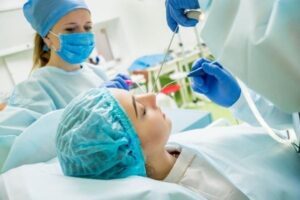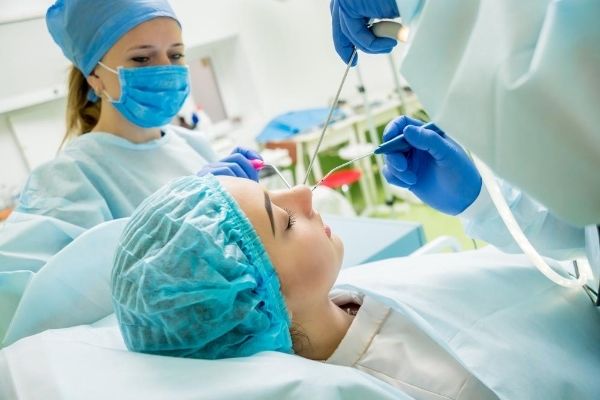Do you have a stuffy nose, pain and pressure in the face, and what feels like a cold that doesn’t go away for months? You may have chronic sinusitis (sinus infection / inflammation), a common condition experienced by many people in the Los Angeles area.
What Causes Sinusitis?
Your sinuses are hollow cavities filled with air in bony areas of your head, located below, above, and behind the eyes as well on either side of the nose. The sinuses have an important function to humidify and moisturize the air we breathe and filter out allergens, pollutants, irritants, and germs so that they don’t get to our throat and lungs. Inflammation in the nasal and sinus pathways can occur, however, causing mucus and pathogens to get trapped in the sinuses, leading to lingering and long-lasting infection. This inflammation can be caused by environmental allergies, pollutants, irritants or structural issues (polyps, deviated septum, large turbinates, etc.).
There are four types of sinusitis: acute, chronic, subacute and recurrent acute sinusitis. Acute sinusitis lasts for less than two weeks or up to 20 days and may include cold-like symptoms such as stuffy nose and facial pressure or pain with colored nasal discharge. Subacute sinusitis has symptoms lasting from 3-12 weeks, but chronic sinusitis is symptoms like congestion, facial pressure/pain, postnasal drip, colored nasal discharge, headaches, cough and sore throat lasting for more than 12 weeks. Recurrent acute sinusitis is where patients develop acute sinusitis symptoms more than 3-4 times per year needing evaluation by a doctor and treatment with antibiotics, decongestants, rinses, sprays and antihistamines.
With chronic sinusitis, you may have:
- Nose congestion
- Decreased or loss of smell and/or taste
- Pain or pressure in the face, head or around the eyes
- Thick, discolored drainage from the nostrils or down the back of the throat
- Nausea
- Bad breath
- Fatigue
- Coughing that gets worse when lying down
- Achy feeling in the upper jaw, teeth, and/or ears
A qualified sinus specialist like Dr. Alen Cohen can diagnose chronic sinusitis or recurrent acute sinusitis or any of the conditions above. Patients with these conditions find temporary relief through home remedies and other treatments, but often balloon sinuplasty is the best and most definitive option providing permanent and lasting relief.
What Balloon Sinuplasty Does
Balloon sinuplasty is a safe, minimally-invasive procedure that can be performed right in the doctor’s office under local / topical anesthesia. It can quickly and safely open the pathways between all of the sinuses and the nostrils allowing air to flow in freely and the sinuses to drain properly. The benefits of in-office balloon sinuplasty significantly outweigh the risks and can often be felt quickly after the procedure!
You have four pairs of paranasal sinuses:
- Ethmoid sinuses: on either side of the bridge of your nose between the eyes
- Frontal sinuses: above the eyebrows in forehead
- Maxillary sinuses: on either side of your nose below your eyes and behind each cheek
- Sphenoid sinuses: behind the eyes
The pairs of sinuses most commonly targeted in balloon sinuplasty are the frontal sinuses, maxillary sinuses, and the sphenoid sinuses. The goal of balloon sinuplasty is to restore the proper diameter of the sinus passageways, allowing air and mucus to once again flow freely in and out of the sinuses.
What is the Procedure Like
In-office balloon sinuplasty is convenient for a number of reasons. When performed in-office, a balloon sinuplasty is much less expensive than a procedure performed in a hospital or surgical center—many people owe only an office co-pay. The procedure also is quick, carries minimal risk for complications, and has a fast recovery time.
An in-office balloon sinuplasty only takes about half an hour and uses local anesthesia very similar to a dentist, which is numbing medication for the inner nose and sinuses so that you’ll be awake but won’t feel pain during the procedure.
A small catheter with a deflated balloon on the end is placed into the nose through each nostril and passed through to the sinuses. Your sinus specialist (Dr. Cohen) then dilates this balloon at the sinus openings and expands the drainage pathways to 3-4x normal in size. This expansion inside the entrances to the sinuses allow the balloons to widen and properly restructure the walls of the nasal and sinus passageways. When the balloon catheters are removed, the walls of the sinus passageways remain open, just as they were when the balloon was expanded so that air and mucus can flow freely from the nose, reducing the risk of future sinus infections.
Other procedures for sinus relief
Most patients may also be candidates for a turbinate reduction procedure, which is often performed at the same time as a balloon sinuplasty procedure. This is where the turbinates at the bottoms of your nose are liposuctioned to improve the flow of air into the nasal passages permanently. For patients with chronic sinusitis caused by a severe deviated septum, massive polyps, growths, or tumors, an endoscopic sinus surgery may be more appropriate, safe, and effective in an outpatient surgery center.
What to Expect During Recovery
Because the procedure is minimally-invasive and only requires local anesthesia, recovery can be very quick, although recovery times may vary for each person. Most people can return to work and resume regular activities within a day or two after balloon sinuplasty. At SoCal Sinus, we often perform balloon sinuplasty on Fridays for patients, so that they can return to work by Monday. As with any medical procedure, following all of your doctor’s instructions are critical so your recovery goes more smoothly. Most patients are feeling amazing between 1-3 weeks after the procedure and wishing they had it done years earlier!
After the local anesthesia wears off from the procedure, many people feel immediate relief from sinus pain and pressure with an improved ability to breathe through the nose. Most people experience minimal discomfort and bleeding following surgery. You’ll be given aftercare instructions and a saline solution to rinse your nasal passageways for up to 3-4 weeks after surgery. Most patients are given antibiotics to minimize the risk of infection, but most people won’t need any prescriptions for pain relief.
As the sinuses recover, it’s normal to experience some minor symptoms, like bloody nasal discharge, swelling of the nose, and minor congestion. Contact your doctor if you develop any extreme symptoms, such as sharp sinus pain, fever, or excessive bleeding or swelling.
Find out if In-Office Balloon Sinuplasty is Right for You!
In-office balloon sinuplasty is a highly effective long-term treatment for sinusitis for many people. The Southern California Sinus Institute is Los Angeles’ Premier Center for Balloon Sinuplasty and has also been recognized as a Stryker Sinus Center of Excellence. Dr. Cohen is one of the pioneers of this procedure in the country and trains various sinus surgeons from all over the United States on how to safely and effectively perform this procedure in the office under local anesthesia with little to no down time. As such he has performed over 5,000 Balloon Sinuplasty procedures and 10,000 sinus procedures in his lifetime and has tremendous experience with this procedure.
Contact us today and let Dr. Alen Cohen get you onto the road to better health and a better life.

